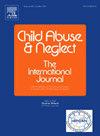Sisonke Ntwana: Describing the mechanisms of change of an arts-based intervention for pregnant and parenting adolescents experiencing violence and poor mental health in South Africa
IF 3.4
2区 心理学
Q1 FAMILY STUDIES
引用次数: 0
Abstract
Background
In South Africa, one in five adolescents experience pregnancy and face heightened rates of interpersonal violence and mental health challenges. Yet, few interventions are tailored to them.
Methods
28 pregnant adolescents reporting past year intimate partner violence and/or non-partner rape were purposively recruited in antenatal clinics in Johannesburg to attend a 6-session arts-based intervention, delivered by 4 graduate art therapy students alongside clinical supervision. Arts-based processes of collage, body mapping, projective drawing, and sandtray with psychoeducation, mindfulness practice, and safe parenting skills, were facilitated. Feasibility, and mechanisms of change were assessed through a focus group discussion with participants (n = 7) and endline interviews with participants (n = 18), interventionists (n = 4), and lived experience researchers (n = 4). Data were managed in Dedoose software and thematically coded.
Results
Mutual care ameliorated feelings of loneliness and provided opportunities to observe others in similar circumstances. High quality therapeutic interactions helped generate socioemotional skills and hope. Being able to “speak the unspeakable” through artistic engagement and dialogue via image making fostered critical awareness and insight. Improved self-expression was described, recognizing an “embodied approach” as preferable to talking alone. Psychoeducation helped understand physiological responses in pregnancy and how trauma operates across generations. Several participants felt the intervention was too short and raised privacy concerns in a group format. There was some initial trepidation using novel art materials.
Conclusions
Findings confirm the therapeutic advantage of integrating non-verbal methods in treating adolescent mental health. Sisonke Ntwana holds potential for supporting pregnant and parenting adolescents during a pivotal life stage.
求助全文
约1分钟内获得全文
求助全文
来源期刊

Child Abuse & Neglect
Multiple-
CiteScore
7.40
自引率
10.40%
发文量
397
期刊介绍:
Official Publication of the International Society for Prevention of Child Abuse and Neglect. Child Abuse & Neglect The International Journal, provides an international, multidisciplinary forum on all aspects of child abuse and neglect, with special emphasis on prevention and treatment; the scope extends further to all those aspects of life which either favor or hinder child development. While contributions will primarily be from the fields of psychology, psychiatry, social work, medicine, nursing, law enforcement, legislature, education, and anthropology, the Journal encourages the concerned lay individual and child-oriented advocate organizations to contribute.
 求助内容:
求助内容: 应助结果提醒方式:
应助结果提醒方式:


